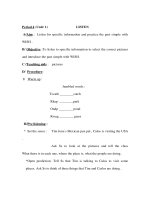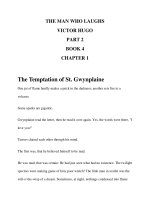4 3 1 sensational seasons
Bạn đang xem bản rút gọn của tài liệu. Xem và tải ngay bản đầy đủ của tài liệu tại đây (2.51 MB, 10 trang )
Suggested levels for Guided Reading, DRA,™
Lexile,® and Reading Recovery™ are provided
in the Pearson Scott Foresman Leveling Guide.
Earth Science
Sensational
Sensa
tional
Seasons
by Ben Scott
Genre
Expository
nonfiction
Comprehension
Skills and Strategy
• Cause and Effect
• Compare and
Contrast
• Ask Questions
Text Features
•
•
•
•
Diagrams
Captions
Labels
Glossary
Scott Foresman Reading Street 4.3.1
ISBN 0-328-13442-2
ì<(sk$m)=bde ch< +^-Ä-U-Ä-U
Reader
Response
Sensational
Seasons
1. Reread page 6. What causes the day to be longer
in the summer in the northern hemisphere? What
is an effect of the summer season? Write your
by Ben Scott
responses in a chart similar to the one below.
Cause
Effect
2. Reread page 10. If you could interview Aldo
Leopold, what questions would you ask him?
Where could you go to find more information
about plant growth during certain seasons?
3. Use the Glossary and a dictionary to find three
meanings of draft. Use each meaning in a
sentence.
4. How does the diagram on pages 4 and 5 help you
understand how the Earth moves?
Editorial Offices: Glenview, Illinois • Parsippany, New Jersey • New York, New York
Sales Offices: Needham, Massachusetts • Duluth, Georgia • Glenview, Illinois
Coppell, Texas • Ontario, California • Mesa, Arizona
Seasons Change and Have Patterns
The first humans on Earth must have been
fascinated by wildflowers in spring. The more
timid people might have hidden in terror from
the summer sun. They were probably happy to
see colored leaves in fall and designs etched by
the winter frost. Why do the seasons change and
have patterns?
Winter
Spring
Fall
Summer
Every effort has been made to secure permission and provide appropriate credit for
photographic material. The publisher deeply regrets any omission and pledges to
correct errors called to its attention in subsequent editions.
Unless otherwise acknowledged, all photographs are the property of Scott Foresman,
a division of Pearson Education.
Photo locators denoted as follows: Top (T), Center (C), Bottom (B), Left (L), Right (R),
Background (Bkgd)
Opener: (Bkgd) Corbis, (C) Brand X Pictures, (CR) David Lyons/DK Images, (BR) Getty
Images; 2 Corbis; 3 (CR) Brand X Pictures, (CL) Corbis, (BR) David Lyons/DK Images,
(BL) Getty Images; 4 Getty Images; 6 DK Images; 8 ©Stockbyte; 9 Corbis; 10 Digital
Vision; 11 Theo Allofs/Visuals Unlimited; 12 Getty Images; 13 (TR) DK Images, (C) Getty
Images; 14 Getty Images; 15 Getty Images
ISBN: 0-328-13442-2
Copyright © Pearson Education, Inc.
All Rights Reserved. Printed in the United States of America. This publication is
protected by Copyright, and permission should be obtained from the publisher
prior to any prohibited reproduction, storage in a retrieval system, or transmission
in any form by any means, electronic, mechanical, photocopying, recording, or
likewise. For information regarding permission(s), write to: Permissions Department,
Scott Foresman, 1900 East Lake Avenue, Glenview, Illinois 60025.
2 3 4 5 6 7 8 9 10 V0G1 14 13 12 11 10 09 08 07 06 05
3
Our Wonderful World
Suppose that Earth is a toy top spinning in
slow motion. You, the spinner of the top, are the
Sun. One full turn of the top equals one day. The
side facing you is in daylight. It is night on the
other side.
Earth
Earth spins on its axis. The axis is an imaginary
line through the center of Earth. Earth spins on
its axis as it travels around the Sun. Each spin
takes one day. Each trip around the Sun takes
one year.
Earth tilts on its axis as it spins. The half of
Earth tilting toward the Sun is warmer than the
half that is tilting away. The tilt of Earth as it
travels around the Sun gives us our seasons.
Sun
Axis
The direction
the Earth travels
around the Sun
4
5
The Seasons
There are twelve hours of daylight and twelve
hours of darkness on the first day of spring. The
Sun is directly over the equator on this day.
Then daylight hours get longer. The northern
half of Earth, called the northern hemisphere,
tilts toward the Sun. The first day of summer has
the most sunlight of the year. The weather is
warmer because the Sun’s rays hit the northern
hemisphere more directly.
Equator
How the seasons change
as Earth circles the Sun
Then Earth’s axis starts to tilt away from
the Sun. Rays of sunlight reach the northern
hemisphere less directly. The weather cools.
There is less daylight.
The Sun is also over the equator on the
first day of fall. Equal amounts of Sun reach
the northern and southern hemispheres. The
northern hemisphere keeps tilting farther
away from the Sun. The first day of winter is
the shortest day of the year in the northern
hemisphere.
Equator
First Day of Winter
December 22
First Day of Spring
March 21
Sun over Equator
The northern hemisphere tilts
toward the Sun in the summer.
It tilts away in the winter.
Equator
First Day of Fall
September 23
Sun over Equator
First Day of Summer
June 21
6
Equator
7
Sing for Springtime
Wood anemone
There are also many signs on the ground that
a new season has begun. For example, birds sing
more in the spring. Male birds sing to warn other
birds to stay away from their areas. This way they
can safely find food. The birds raise their families.
A starling sings.
The amount of sunlight during
the day affects most plants.
Sunlight tells plants when to
start making leaves or flowers.
For example, the wood anemone
reacts to short days. It grows
flowers in early spring.
8
9
The Days of Summer
Summer is a time of growth in the natural
world. Naturalist Aldo Leopold studied living
things. He counted many species of plants that
bloomed during July and August on his farm in
Wisconsin. Plant growth helps birds and other
animals find food.
Birds and other animals begin to molt in early
summer. This means that they begin to lose their
feathers or fur. They grow new coats for the
winter. Animals may also gain weight. They store
fat to help them get through the cold season.
Molting feathers
Wildflowers in a meadow
10
11
Frost Comes in the Fall
Deciduous trees lose their leaves in the fall.
The trees draw back food from the leaves. The
leaves turn brown, red, and yellow. Then they
fall off.
Evergreen trees have needles instead of
leaves. They lose a few needles in the fall. Most
of the needles stay on the trees all year long.
Some birds fly south in the fall. They will
spend the winter where it’s warmer. Birds are
not the only animals that migrate when the
days get colder. Many monarch butterflies fly
more than two thousand miles south to Mexico.
Monarch butterflies
migrate south for
the winter.
Many trees
lose their
leaves in
the fall.
Evergreens only lose
a few needles. These
trees stay green
throughout the year.
12
13
Winter Wonderland
Many wild animals survive the drafts of winter
by going to sleep. Hedgehogs, bats, and some
mice are hibernators. Their body temperatures
fall. Their breathing and heartbeat rates become
much slower. These animals live off their stored
body fat in the winter.
A squirrel’s nest of
leaves and twigs
keeps the squirrel
from freezing in
the winter.
14
Most animals do not have a market for food.
They don’t have a cozy parlor to help them keep
warm in the winter. Animals are adapted to the
cold. Soon the cold winter days will pass and
spring will come again. Then the hibernating
animals will wake up. Another cycle of seasons
will begin as Earth circles the Sun.
Animals such as frogs,
snakes, and turtles may also
sleep through the winter.
15
Glossary
Reader Response
drafts n. currents of air.
parlor n. a sitting room.
etched v. engraved a
drawing or design.
terror n. great fear.
fascinated v. interested
greatly; attracted very
strongly; charmed.
timid adj. easily
frightened; shy.
1. Reread page 6. What causes the day to be longer
in the summer in the northern hemisphere? What
is an effect of the summer season? Write your
responses in a chart similar to the one below.
Cause
Effect
frost n. a freezing
condition; temperature
below the point at
which water freezes.
2. Reread page 10. If you could interview Aldo
Leopold, what questions would you ask him?
Where could you go to find more information
about plant growth during certain seasons?
3. Use the Glossary and a dictionary to find three
meanings of draft. Use each meaning in a
sentence.
4. How does the diagram on pages 4 and 5 help you
understand how the Earth moves?
16









